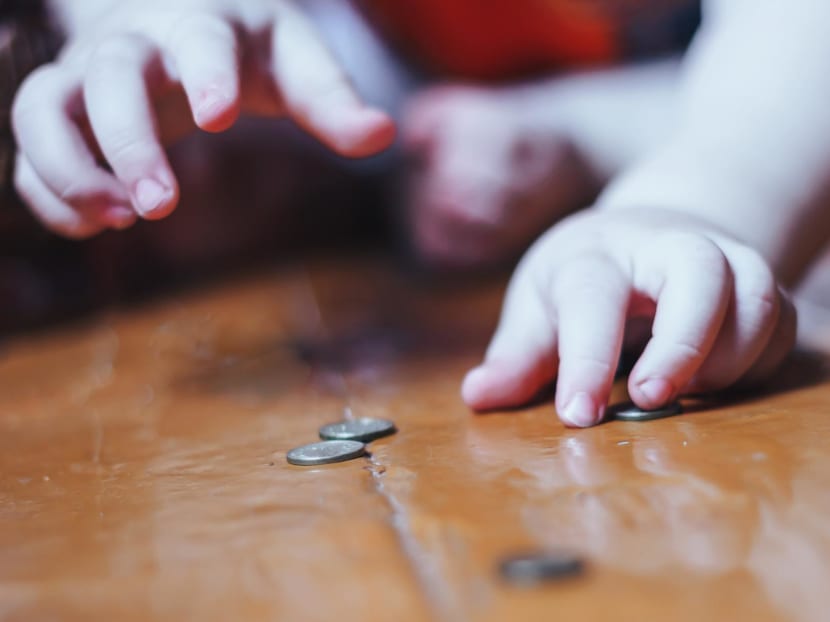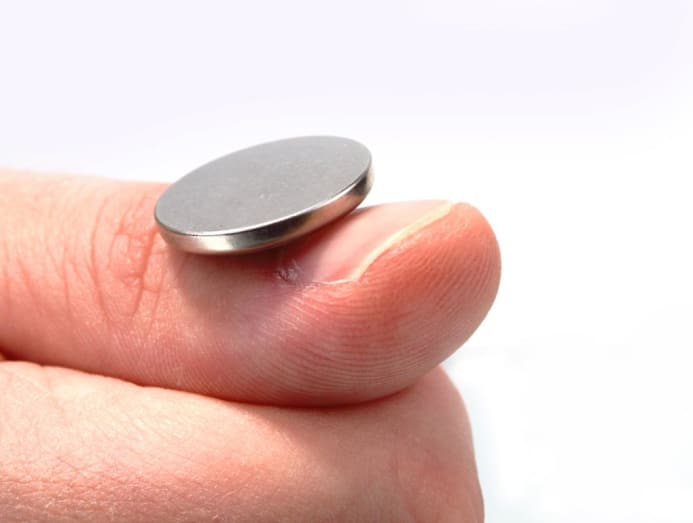Kids swallowing objects: How long does it take for a coin, battery or magnet to pass through?
A Singapore study has provided paediatricians with a better understanding on the follow-up required – and whether you can wait and let your child pass it out.

According to a local study, coins are the most common objects swallowed by toddlers aged one to two. (Photo: iStock/Nestea06)
The sight of your child choking, unable to breathe or cough, and turning blue in the face is enough to make you hightail it to the nearest A&E department. In some instances, children who have swallowed foreign objects may complain of pain in the throat, chest or abdomen instead; they may also drool, refuse to eat or vomit.
If the swallowed object manages to uneventfully travel down the throat and into the food pipe or oesophagus, you’d be likely told to take your little one home and let nature take its own course. In other words, let Junior poop out the ingested item.
But here’s where it can get a little disconcerting for parents: How long would it take for a swallowed coin, bead, button battery or magnet to transit out of your child’s body?
In the first place, toddlers from ages one to two, who are at the mouthing stage of their development, are at the highest risk of such incidents. That’s when they learn about their environment by putting objects they find into their mouths to gauge their size, shape, texture and density – and sometimes, swallowing the objects by accident.

It is no surprise that the largest single age group seen at the A&E departments in National University Hospital (NUH), and KK Women’s and Children’s Hospital belong to this age range, according to a recent study by Khoo Teck Puat - National University Children’s Medical Institute (KTP-NUCMI) at NUH.
The study analysed medical records from 2015 to 2016 on over 2,100 local children and adolescents, who were treated for swallowing foreign objects. They were all under the age of 18, and 70 per cent of them were below age six.
WHAT ARE THE COMMONLY SWALLOWED OBJECTS?
Ingested items are typically categorised into low- or high-risk objects. The former includes coins, marbles, beads and anything that is small, rounded and is least likely to cause complications when swallowed, according to Associate Professor Marion Aw, the head and senior consultant from Division of Paediatric Gastroenterology, Nutrition, Hepatology and Liver Transplantation at KTP-NUCMI.
On the other hand, high-risk objects can be multiple small magnets that can get stuck in the gastrointestinal tract, and sharp objects for obvious reasons. Assoc Prof Aw also listed button batteries as “high risk”. “Theoretically, the contents within the battery can leak out and cause injury to the lining of the stomach or intestines.”
The study found that coins were the most commonly ingested objects (41 per cent), followed by toys such as beads and marbles (27 per cent). High‑risk objects including multiple magnets, batteries or sharp objects made up 21 per cent of the cases.
WHY TRACK HOW LONG THE SWALLOWED OBJECTS TAKE TO EXIT THE BODY?
Understanding how long it takes for swallowed objects to pass out of the body would help paediatricians decide how soon the follow-up should be, said Assoc Prof Aw, who is one of the researchers involved in the study.
Currently, paediatricians do not have this information as “the majority of the children did not keep the outpatient appointments given”, said Assoc Prof Aw, which led doctors to believe that the objects were all passed out prior to their appointments. As a result, “we would not have the exact timeframe that this happened”.
The study’s findings corroborated this: Only 350 patients (average age of four) followed through with their outpatient appointments.

So, what has the study found? According to Assoc Prof Aw, 50 per cent of the button batteries were passed out by Day 4 and 100 per cent by Day 7. “For coins, 50 per cent were passed out by Day 8 and 100 per cent by Day 37,” she said.
“This means we can potentially advise parents that they can wait till Day 30 to see if the coin has been passed out spontaneously, and we do not have to see the child unless the coin has not been passed out after five weeks. But for children who swallowed batteries, we may want to see them by Day 7,” she said.
HOW LONG DO OBJECTS TAKE TO BE PASSED OUT ANYWAY?
“The way swallowed objects pass is very similar to the passage of food,” said Assoc Prof Aw. But because these objects are not digested, “there are certain parts of the gastrointestinal tract” where “these objects are more likely to get stuck”.
These are usually the “transition points” such as where the oesophagus connects to the stomach, the stomach to the small intestine and the small intestine to the large intestine, she said.
If the object is not lodged in the throat but progresses down the oesophagus, it would enter and exit the stomach, and pass into the small intestine within four to six hours. “However, it is also possible that it may take more than one to two days for it to pass out of the stomach. For safer objects such as a coin, we can sometimes wait up to several weeks before active intervention,” said Assoc Prof Aw.
WHAT ABOUT ADULTS?
The incidence of ingested foreign bodies in adults is generally much lower than in children, said Dr Brandon Koh Chi Ping, a senior consultant with National University Hospital’s Emergency Medicine Department.
But that’s not to say it doesn’t happen. Dentures are commonly involved, along with fish and chicken bones, according to this study on adults who have accidentally swallowed foreign objects. In about 80 per cent of the cases, the object gets passed out of the body, while about 20 per cent required endoscopy and less than 1 per cent underwent surgery.
Some of these ingestion incidents aren’t accidental. “They may be related to underlying psychiatric conditions” and include objects such as paper clips or even razor blades, said Dr Koh. Whether accidental or intentional, adults “should come to the hospital for evaluation and treatment”, he said.
The next stretch of the object’s journey down south is through the small intestine into the large intestine (also known as colon), rectum and finally out of the body through the anus. The colon transit time varies from child to child, although some medical literature cites 36 hours as average, regardless of age and gender.
“I suspect for children who are chronically constipated, it would take a longer time to be passed out. However, we have not done a formal study to demonstrate this,” said Assoc Prof Aw.
WHAT TREATMENT DO DOCTORS USE?
An X-ray would first be taken to assess the position of the swallowed object. If you’re wondering, laxatives aren’t typically used, said Assoc Prof Aw, unless the child has constipation and the swallowed item is deemed to be low risk in nature.
If the object is lodged in the oesophagus, endoscopy would be used to extract it. Once the object has gone past the oesophagus, it depends.
“For high-risk objects in the stomach, such as sharp objects and button batteries, we would go in and remove them.” As for the low-risk objects, “we would adopt a wait approach as most of them would pass out harmlessly”.

What if the object has already moved into the intestines? “The best option is to wait for it to be passed out spontaneously if the child is asymptomatic. If the child has complications, the next option is surgical intervention,” said Assoc Prof Aw.
Surgery is only used in children when risky objects are involved. “One of the riskiest objects are multiple magnets. They can stick to each other across the intestines and not be passed out of the body. They can also cause perforation in the intestine because of the pressure they exert,” said Assoc Prof Aw.
To save parents from the heartache and worry, prevention is better than cure. “It is extremely important not to let young children put small, inedible objects into their mouth – especially sharp objects, button batteries and magnets. For infants and toddlers, they can play with objects larger than their fist.”
Read this story in Bahasa Indonesia here.








